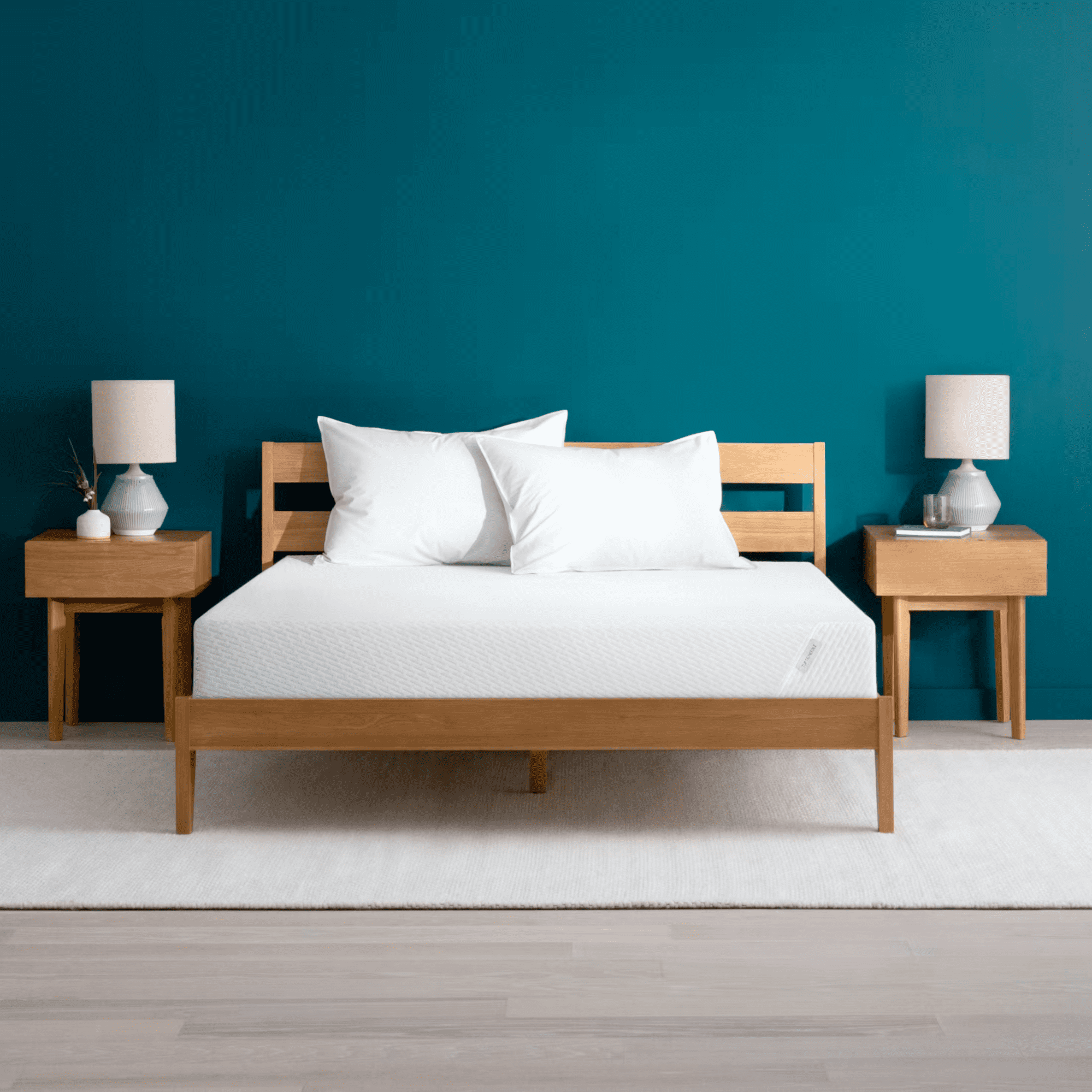Mattresses generally consist of several layers that combine to provide comfort and support. Each layer could contain one of several materials, all of which have potential benefits and drawbacks. Different types of mattresses vary in their materials.
Understanding how the layers and their materials impact performance can help you select the mattress that best fits your needs. We’ll explain how mattresses are constructed and look at each layer in depth. We’ll also discuss what determines the firmness and thickness of a mattress.
How Is a Mattress Constructed?
Mattresses typically have a layered construction that may include one or more comfort layers, a transitional layer, and a support core. These layers are encased in a mattress cover and work together to create a specific feel.
However, there are exceptions to this standard design. For example, some mattresses do not include a transitional layer, and some don’t have much by way of comfort layers. Additionally, there are a few mattress models that consist of just one layer.
Comfort Layers
The comfort layers are the uppermost part of the mattress. They directly impact its firmness, motion isolation, contouring, and temperature regulation. Some mattresses have multiple comfort layers that work together as a comfort system. Most comfort systems are 1 to 4 inches thick. They commonly contain memory foam, polyfoam, latex, wool or cotton batting, or a combination of several materials.
Memory Foam: Memory foam, or viscoelastic polyurethane foam, is a close-conforming synthetic material that molds to the body in response to your body temperature. It’s popular for its excellent motion isolation and pressure relief. Since it adjusts to the shape of your body, a memory foam comfort layer can help support the spine and limit aches and pains. Many compare the feel of memory foam to a hug.
Polyfoam: Polyfoam is a synthetic material. It varies in formulation and density, leading to significant differences in performance. Some types aim to replicate the feel of memory foam, while others mimic the responsiveness and support of latex. In general, polyfoam doesn’t hug as closely to the body as memory foam, but it responds more quickly to changes in pressure.
Latex: Mattresses may contain natural, synthetic, or blended latex comfort layers. This material has a bouncy feel that makes it easier to move across the surface. Latex offers moderate contouring with minimal sinkage. Because of its open-cell structure and lack of hug, latex also tends to regulate temperature well.
Wool or Cotton Batting: Wool and cotton batting contain natural fibers, making them common in the comfort layers of mattresses designed for sustainability. Both materials are soft and breathable, providing cushioning without restricting airflow.
Transitional Layers
Transitional layers come between the comfort system and the support core. Most are made of 1 to 3 inches of denser, firmer material intended to serve as a buffer to prevent sleepers from sinking into the mattress core. Transitional layers commonly use polyfoam, latex, encased or wrapped minicoils, or memory foam. However, not all mattresses contain transitional layers. Simpler designs often have a comfort system placed directly on top of the support core.
Polyfoam: Polyfoam comes in many different densities and can be used in any mattress layer. Transitional layers often employ medium- to high-density polyfoam to deepen the contouring while preventing the sleeper from sinking excessively.
Latex: Latex transitional layers offer responsiveness and bounce. Since latex tends to be quite durable, a transition layer made of this material can help prevent excessive sinkage while resisting long-term indentations as the mattress ages.
Encased or Wrapped Minicoils: Transitional minicoils pocketed in foam or fabric move independently to deepen the contouring and reduce motion transfer. Minicoils also enhance airflow and bounce, keeping the surface cooler and more responsive.
Memory Foam: A memory foam transitional layer typically increases the contouring of the comfort layer while smoothing the transition to the core. Some models combine memory foam comfort and transitional layers for deeper cradling. Others use a polyfoam or latex comfort layer with a memory foam transitional layer to provide contouring while limiting heat buildup.
Support Cores
The support core is generally the thickest portion of a mattress, usually measuring between 6 to 10 inches. This base layer stabilizes the surface and provides additional support. Most cores use firm polyfoam, latex, coils, or air chambers.
Polyfoam: All-foam models contain high-density polyfoam cores, which often lack the level of support associated with coils. This can lead to more sinkage, particularly along the edges of the mattress. Sagging edges can limit the usable surface space and make it more difficult to get into and out of bed.
Latex: All-latex mattresses generally use Dunlop latex cores. Due to the manufacturing process, Dunlop latex is quite dense and bottom-heavy, providing durable support.
Coils: Steel coils offer excellent edge support, bounce, and breathability. Hybrid models usually use pocketed coils that move independently to isolate vibrations. Innerspring mattresses often contain more traditional types of coils that tend to be less expensive but more prone to motion transfer, such as Bonnell or continuous wire coils.
Air Chambers: Airbeds use adjustable air chambers for support. Adding air increases the surface’s firmness, while releasing it makes the surface softer. Most airbeds have two or more air chambers, allowing each sleeper to adjust the firmness on their side. Some airbeds have additional air chambers so that sleepers can fine-tune the firmness beneath different areas of their bodies.
Mattress Covers
Mattresses are encased in fabric covers, which are commonly made of cotton, wool, polyester, Tencel lyocell, or fabric blends. Most popular cover materials are breathable so that air can circulate into and out of the mattress, dissipating heat. Wool, polyester, and Tencel lyocell are also designed to wick moisture, which can help keep you dry throughout the night.
Some covers contain specialty materials intended to actively cool the surface, such as phase change material, copper, or silver. Pillow-top and Euro-top covers also have foam or other material quilted in for cushioning.
A mattress may use removable, machine-washable covers for easy cleaning. However, most covers are not designed to be removed, and doing so could void the warranty. In this case, spot cleaning may be the best option. Consult the warranty policy for more information.
Shop the Best Mattresses of 2024What Determines the Firmness and Thickness of a Mattress?
A mattress’ profile depends on its thickness and number of layers. Most mattresses are 8 to 12 inches thick, though low-profile and high-profile options are also widely available.
The thickness of the mattress tends to correlate loosely with the firmness. Thicker models commonly have more substantial comfort systems and a softer feel. On the other hand, lower-profile models usually have thinner comfort systems and a firmer feel. This is a general trend, but it is not a consistent rule. You can also find firm high-profile mattresses and soft low-profile models.
We describe firmness on a scale of 1 to 10, where 1 is the softest and 10 is the firmest. It’s rare to find mattresses below 3 or over 8 on the firmness scale. Most sleepers prefer models that rate between 4 and 7.
Mattress firmness levels are largely subjective. Sleepers should consider their body type and position preferences when choosing a mattress.
Individuals who weigh under 130 pounds often prefer softer mattresses. People who weigh between 130 and 230 pounds generally find medium to medium firm models most comfortable. Those over 230 pounds tend to favor firmer, more supportive surfaces.
Preferences can vary by sleep style, too. Side sleepers usually need a somewhat softer mattress to cradle their hips and shoulders, whereas stomach sleepers typically require something firmer so that their midsections don’t sag. Back sleepers tend to fall in the middle.
How Are Flippable Mattresses Constructed?
Flippable mattresses have a reversible design with a core in the middle to provide support regardless of which side of the mattress you use. Each side can then have a separate comfort system and transition layer. Some models contain the same materials on both sides to prolong the life of the mattress by enabling you to spread out wear and tear. However, many use different constructions for the two surfaces to provide distinct firmness levels. The comfort and transition layers may vary in material, thickness, and density to achieve this effect.
Ask the Sleep Doctor
Have questions about sleep? Submit them here! We use your questions to help us decide topics for future articles, videos, and newsletters. We try to answer as many questions as possible. You can also send us an email. Please note, we cannot provide specific medical advice, and always recommend you contact your doctor for any medical matters.







